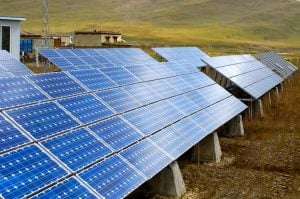A slowing economy and the coronavirus pandemic has prompted China’s leadership to call for faster construction of “neo-infrastructure” such as data centres and 5G networks, to stabilise investment and provide high-quality growth.
The concept of “neo-infrastructure” arose in a Central Economic Work Conference in late 2018, to refer to digitalisation and smart technology, as opposed to traditional infrastructure like roads and railways. The coronavirus pandemic has pushed the idea to new prominence.
But the energy and climate impacts need to be considered. Construction of data centres and 5G networks should be low-carbon and based on market demand, not blind enthusiasm. The government should continue overseeing data centre expansion and energy efficiency improvements, and steer the sector towards greater use of renewable energy. This will aid the economic recovery in the near term and provide sustainable growth for the long term.
Neo-infrastructure expansion
Last June, the Ministry of Industry and Information Technology began issuing 5G licences. Commercial use followed in October and investment expanded rapidly. The ministry’s own statistics for 2019 show 130,000 5G base stations installed by the end of that year, with user numbers increasing by one million a month.
The year will be crucial for the 5G roll-out. Nineteen provinces list “promoting construction of 5G networks” as a key priority, and over 200 provincial-level policy documents on 5G have been published. The three major mobile operators – China Mobile, China Telecom and China Unicom – along with state-owned telecommunication tower firm China Tower, will invest 197.3 billion yuan ($28 billion) in 5G networks. Around 550,000 base stations, covering all prefecture-level cities, are expected to be operational by the end of the year.
Data centre investment is also ramping up. In 2019, China had about 74,000 data centres, 23% of the global total. The last three years have seen investment in data centre software and hardware increase by an average of 15% a year – almost twice the global average rate of growth.
One hundred major data centre projects, both those serving specific corporations and internet users more generally, are in the planning pipeline this year, according to lists published by reform and development authorities at the provincial level. Consultants IDCquan estimate that China’s internet data centre (IDC) market, including server hosting, content delivery network services and public cloud services, will be worth 320.1 billion yuan ($45 billion) by 2022 – a 15-fold rise on 2012.
Energy issues
As 5G networks and data centres expand, so does the energy they consume to run and cool the equipment 24 hours a day. These two needs each account for about 40% of a data centre’s total energy use, according to the 2016 China Data Center Cooling Report.
China’s data centres consumed 161 billion kilowatt hours of electricity in 2018, according to a report published last year by Greenpeace and North China Electric Power University. That is 2% of the country’s total usage and more than the city of Shanghai. Data centre power consumption is projected to grow 66% by 2023, to 267 billion kilowatt hours.
By 2023 China’s data centres alone will produce 163 million tonnes of carbon emissions – equivalent to a medium-sized country.
Assuming China’s energy mix remains the same, the report estimated that by 2023 its data centres will produce 163 million tonnes of carbon emissions – equivalent to those of a medium-sized country.
5G networks are also facing energy challenges. According to a Huawei white paper on telecommunications sector energy targets, 5G energy consumption per unit of data is a tenth that of 4G. But 5G requires two to three times as many base stations and carries more data. So energy consumption per base station is between 3 and 3.5 times that of 4G, and overall network power consumption will double, to over 100 billion kilowatt hours.
Research from Canada’s McMaster University predicts that by 2040 information and communications technology (ICT) will account for 14% of global emissions, up from 1.6% in 2007, with data centres accounting for 45% of this, telecoms networks for 24% and end user equipment for 31%.
Steering towards the green
If China’s neo-infrastructure is to be green and low-carbon, better energy efficiency and a shift to renewable power are crucial.
In a document on energy saving and emissions reduction in the IT and telecoms sectors for the 13th Five Year Plan period, the Ministry of Industry and Information Technology said that “by 2020, energy consumption in the telecoms sector will be on a par with advanced international levels, with a 10% fall in overall energy consumption per service unit on 2015 levels”. It required large data centres (containing over 3,000 server racks) and very large centres (of over 10,000 racks) to achieve power usage effectiveness (PUE) values of less than 1.4 and draw much more energy from new and renewable energy sources. PUE is an important measure of data centre efficiency. The closer the value is to 1, the less power is needed for processes such as cooling, and the more efficient the data centre is.
Interviews carried out in 2019 found that 85% of 200 large and medium-sized firms had data centres with PUE values of between 1.5 and 2.0 – leaving much room for improvement.
China’s digital infrastructure, in numbers
- 74,000 The number of data centres in China in 2019 – 23% of the global total.
- $28 billion Predicted investment in 5G networks in 2020 by China Mobile, China Telecom, China Unicom and China Tower.
- 161 billion kilowatt hours The electricity consumed by China’s data centres in 2018 – more than the city of Shanghai.
The provincial-level city regions, with their high concentrations of data centres, have been first to act, guided in part by the central government’s 13th Five Year Plan targets for energy consumption and intensity.
Beijing, Shanghai and Shenzhen have applied strict PUE rules when approving new data centres, pushing the sector towards greener operations.
In 2018, Beijing brought in a citywide ban on the construction or expansion of internet and information processing and storage data centres, with the exception of cloud computing data centres with a PUE of 1.4 or less. It also implemented a complete ban on data centre construction or expansion in the city centre.
In 2019, Shanghai decided that by 2020, the PUE of new internet data centres must be 1.3 or below, and the PUE of refitted ones must be 1.4 or below. Meanwhile Shenzhen said data centres with a PUE of over 1.4 will receive no subsidies, while those with less than 1.25 can obtain a subsidy of over 40%.
Unlike the explicit energy efficiency target, central government policy on more use of renewable energy in data centres remains one of guidance and encouragement. The overall direction is clear, but there are no specific figures on how far to go.
The report from Greenpeace and North China Electric Power University shows that currently there is no trend towards scaled procurement of renewable energy in China’s data centre industry. In 2018, 23% of the sector’s power came from renewables. Only a few cities have taken the lead and planned for joint development of renewables and data centres. For example, Zhangjiakou in Hebei, where a 2019-2025 plan for big data development aims to see 70% of data centre power come from renewables by 2021, and at least 90% by 2025.
China’s construction of 5G networks and data centres will decide the future of the digital economy – and help determine whether or not the country can achieve low-carbon development.
Zhangjiakou, a national-level pilot city for renewable energy and one of the host cities of the 2022 Winter Olympics, created China’s first “four-way coordination mechanism” in 2017, involving the government, the grid, power generators and users. Via that mechanism, Alibaba and Stack Data purchased 140 million and 95 million kilowatt hours of renewable energy respectively in the first three quarters of 2019, to be used to power their data centres. For the first half of that year, 56% of power used by Stack Data’s Guanting facility in the city came from renewables. In August 2019, Alibaba’s data centre facility drew 40% of its power from renewables.
Central government policy support has seen multiple national-level big data and data centre pilot projects sprout up in renewables-rich provinces such as Guizhou, Sichuan and Inner Mongolia.
Construction of new data centres is currently being shifted from major cities to neighbouring ones and the western provinces. It is hoped that the faster data speeds of 5G networks will intensify the shift to central and western China, which have abundant renewable energy. That would both make use of renewables in the west and, under improving power efficiency policies, promote the sector’s move to green and low-carbon growth by improving its energy mix.
Internationally, there is broad recognition of the need to reduce power use and emissions in data centres and the ICT industry generally. The European Commission recently published a digital strategy document pointing out the EU’s ICT industry can and should become carbon neutral by 2030.
And with the combination of China’s neo-infrastructure plans and green development requirements, the country’s construction of 5G networks and data centres will not just decide the future of the digital economy – it will help determine whether or not China can achieve its goal of green and low-carbon development.






![A picture of a wild boar captured on camera traps installed by WWF-Pakistan to monitor movement of leopards in Galliyat [image courtesy: WWF-Pakistan]](https://dialogue.earth/content/uploads/2020/04/04-300x200.jpg)

